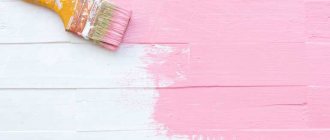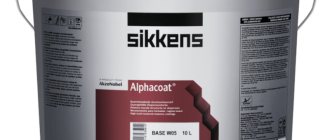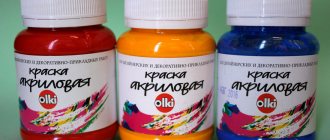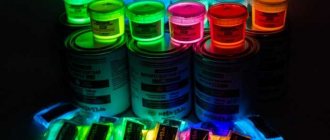» How to get color » How to get gray by mixing paints
How to get gray color and its shades by mixing it with different colors in 9 pictures that will clearly show the tones and the process of combining them. We will build warm and cool gray colors such as mouse, anthracite, morengo and others. There is nothing simpler than gray, however, this shade, as a neutral one, is quite often used in fine art, not in its pure form, but with various answers. It has a lot of undertones, and the range from light to dark is also wide, so mixing the right gray color can sometimes be quite difficult.
How to get gray: mix black and white
Gray color is obtained by mixing white and black, but this proportion cannot be one to one. To get a medium gray tone you need to take at least 5 parts white and 1 (one) black. In practice, it will look like this: squeeze a pea of white paint onto the palette and 3 times less black next to it, then carefully take it on the tip of the brush and dip it into white. By adding drops of dark color to white, you can adjust the degree of darkening of the gray color.
The colors obtained in this way will be “pure” and are the basis for further mixing to acquire any undertone.
What is color and what does it consist of?
Kohler is a special composition with a high level of concentration.
It is offered either in liquid or powder form. Kohler is a special composition with a high level of concentration. It is offered either in liquid or powder form. The material is used so that you can change the color of the paint to the desired shade.
The proposed pigmenting agents have certain features. The main ones include the following:
- On sale you can find a minimum number of shades of color, presented in dry form. It is more difficult to use due to the fact that it first needs to be soaked in a diluent for some time. It is important to consider the type of paint. The only advantage is the relatively low price of the material.
- Liquid color dissolves very well, but you will need to select a substance taking into account the binder component of the paint. It is worth noting that this color can be used as an independent means to emphasize a specific detail during painting.
- Colors are also available in paste form. It must be mixed very well with the paint to achieve the desired result. It is also important to follow the standards specified by the manufacturer.
Before making your final choice, you need to pay attention to exactly what shades the manufacturer offers.
How to get olive drab color
If you need to paint a shadow cast by greenery on a sunny day, then an olive-gray shade would be ideal. This is a warm, neutral khaki, which is obtained by mixing an existing gray shade with a drop of yellow. Mixing it on the palette will look like this: in front of you is already mixed black and white paint, squeeze out a small amount of yellow paint nearby (about the same amount as black) and add it to the gray with a brush stroke. To create an undertone you need a minimal amount of paint. It is worth considering that yellow is a light paint, so if you have precisely selected the lightness of gray, the resulting shade will be a little lighter than planned.
Features of tinting different paints and varnishes
There are universal colors that can be added to almost any paintwork material. They are suitable for tinting materials for working on interiors and facades.
Tinting pigments with different paints should take into account the following recommendations:
- To paint facades, colors that are resistant to weather conditions and the sun are used. When tinting water-based paint, the mass of pigment for the entire working composition should not exceed 20 percent.
- Pigments for working with water-based paints can be used for tinting adhesive, latex and dispersion compositions.
- The amount of dye when tinting acrylic paints should exceed 9 percent of the total volume of the composition.
The compatibility of paints and pigments largely depends on the manufacturer and composition of the substance.
How to get anthracite tone
Anthracite is a dark shade of gray with a purple undertone. To obtain it, you will need a ready-made, mixed gray color, red and blue, where it is better to take red carmine, and blue – ultramarine. This way you get two composite colors: the main one, which we focused on, and an additional one - purple, which, if it is in the palette, you can take ready-made. We mix tones with a predominance of gray. It is worth taking into account the fact that purple darkens the main tone, so in order to get lighter tones, the mixture will need to be diluted with white.
Features of working with acrylic dyes
Acrylic is easy to use. It takes little time to dry completely, but it has a limited range of colors. For this reason, the shades are created manually. Mixing helps to obtain raspberry, turquoise, flesh and other tones.
When working with acrylic, follow the recommendations:
- Before painting, the surface is cleaned of various types of contaminants. It must be smooth and clean, so the previous finish is removed. Before painting the walls, they are leveled with putty and treated with a primer, reducing the consumption of the paint composition and improving its adhesion.
- Before use, acrylic is diluted with a special solution or water. To do this, take a small amount of the substance and mix it with liquid in a separate container.
- Tools used for staining are thoroughly washed afterwards. The lid of the paint can is wiped so that it can be easily opened in the future.
- Coloring takes place in several stages. For an even coating, paint is applied in one direction. For ease of application, you can use a spray bottle.
- The room temperature should be +5…+17°C.
A mixing scheme was developed for painting with acrylic paints. It is divided into creating light and dark tones and producing green, lilac and violet, orange and earth tones.
Light
To obtain light colors, white is used, to which another paint is added. The more coloring compound is added, the darker the color will be.
By adding a small amount of dye, a variety of light colors are obtained.
Dark
Brown color when adding a certain percentage of paint.
Dark dyes are obtained by adding a little black tint to the base color. This procedure allows you to create different dark colors. Dark paint is used with caution, because... she can turn a dark coloring composition into a dirty one.
Green color
This color is not available in the palette, so it is obtained by combining yellow and blue. Tinting is affected by the ratio of coloring compounds. The required volumes are calculated during the mixing process. There are many color combinations of green. They are obtained by combining base and auxiliary coloring substances of the palette.
Lilac and violet
Cold purple and lilac are obtained from blue and light pink or red dye. White or black is added to the mixture to increase the number of different shades.
Orange
Yellow and red compositions, taken in the same volume, are used to create an orange dye. Its brightness is determined by the amount of initial color.
If orange paint is combined with white, you get a peach, coral or melon tone.
Earthen
There are many ways to produce brown flowers. When burnt umber is mixed with each substance in the color palette, a wide spectrum of colors is obtained, which includes coloring compounds from beige to dark wood.
Table for obtaining gray shades when mixing colors
This is a reminder of how colors should theoretically be mixed to get this or that tone, as well as what percentage of paint affects this color.
In the center is the main color, which is gently mixed with other shades. There is a palette around for mixing. The next circle is mixing the main color with the adjacent color in an amount of 20%, then 50%. From the latter, 2 shades are built: darkened by 20% and lightened by 20%.
How to get other colors and their shades: theory and practice. Click on the icon.
Laws of color mixing
Let's start with the fact that from a coloristic point of view, all colors can be divided into two main categories:
- Chromatic - bright, colorful.
- Achromatic - white, black, gray.
According to one of the rules of color, each chromatic color has an additional tone, which, when mixed with it, produces gray.
In this way, different shades of gray can be achieved depending on the original colors used. This means that this color can no longer be called monotonous.
The next rule of color mixing states that when mixing two colors, you always get a shade that is intermediate in chromaticity between them. In other words, it will always be less bright relative to the most intense color in the pair, and more saturated than the most faded one.
Well, before moving on to the third rule, we need to get acquainted with the color wheel. It represents a conventional model of the interaction of colors, resulting in the appearance of different shades. Also, the colors in the circle are divided into primary, secondary, and sometimes even tertiary. Color wheels are also different, but their task is always the same - to show the interaction and combination of colors and shades. In addition, colors are divided into cool and warm, and sometimes create separate circles for warm and cool shades.
The third rule is that when mixing two primary (primary) colors that are located in the circle closer to the secondary ones, you will get a shade that will be located between them along a smaller arc of the circle.
To better understand the rules described above and understand their use in practice, we will understand how the color gray is obtained.
Basic tips for getting a new color scheme
There are quite a lot of tones. But the production of paints is based on the use of standard colors. Nowadays, non-standard colors are in fashion, which can be obtained by mixing dyes. The following expert recommendations will tell you how to mix colors correctly.
It has been known since childhood that the basis of all tones are three colors: red, blue, yellow.
To get other options, you need to know the rules for mixing paints. The combination of basic dyes gives a wide range of different undertones.
The secret to creating a new color scheme by mixing colors is to use basic dyes in different proportions. For example, when mixing the colors blue and yellow, we get green. If you continue to add yellow to the resulting substance, you can get tones that are increasingly closer to it. It all depends on the volumes that are connected.
On video: how to get a new color.











